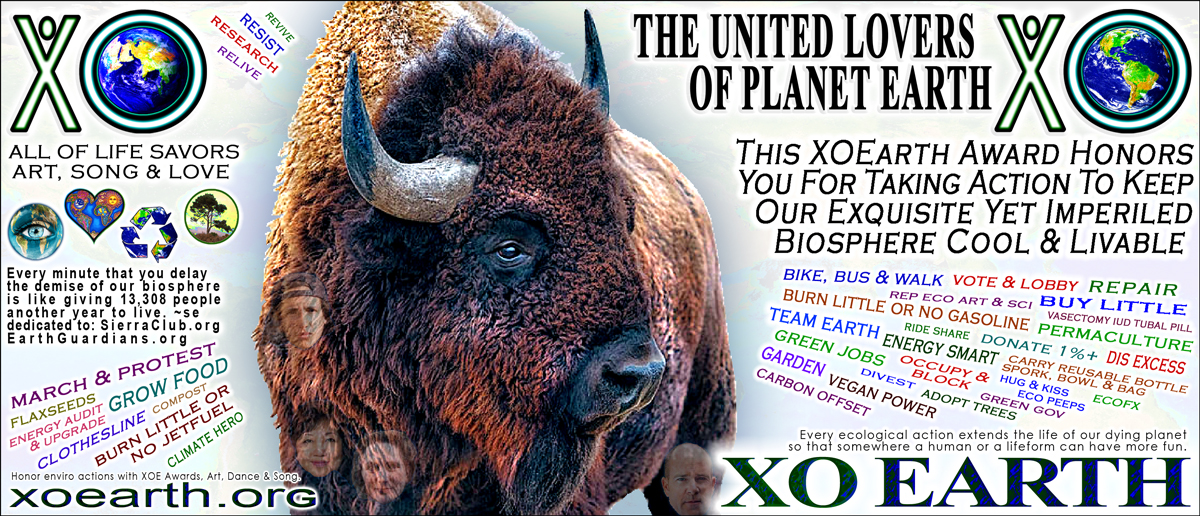

Lovers of our Earth’s biosphere are invited to copy and share, or print and give, these commemorative XOEarth Awards to your government officials, friends, businesses, customers, volunteers and employees to thank them for their environmental actions – either past or pledged.
These Buffalo XOEarth Awards have been dedicated to:
+ The Wild Water Buffalo
+ The Bison
+ The Sierra Club – explore, enjoy, protect the planet
+ Earth Guardians – teaches youth about political action, pesticides, energy grid, conservation and fracking
+ Xiuhtezcatl Martinez – climate change filmmaker, journalist, environmental activist and climate science speaker
+ Loren Blackford – Sierra Club President 2017 – 2018
+ Michael Brune – Executive director of the Sierra Club
+ Susana Reyes – Sierra Club Vice President 2017 – 2018
Bison
Although commonly known as a buffalo in the United States and Canada, it is only distantly related to the true buffalo.Bison are good swimmers and can cross rivers over half a mile (800 meters) wide. They are nomadic grazers and travel in herds. The bulls leave the herds of females at two or three years of age, and join a male herd, which are generally smaller than female herds. Mature bulls rarely travel alone. Towards the end of the summer, for the reproductive season, the sexes necessarily commingle.
Male and female herds usually do not mingle until the breeding season, which can occur from July through September. However, female herds may also contain a few older males. During the breeding season, dominant bulls maintain a small harem of females for mating. Individual bulls “tend” cows until allowed to mate, by following them around and chasing away rival males. The tending bull shields the female’s vision with his body so she will not see any other challenging males. A challenging bull may bellow or roar to get a female’s attention and the tending bull has to bellow/roar back. The most dominant bulls mate in the first 2–3 weeks of the season. More subordinate bulls mate with any remaining estrous cow that has not mated yet. Male bison play no part in raising the young.
Bison herds have dominance hierarchies that exist for both males and females. A bison’s dominance is related to its birth date. Bison born earlier in the breeding season are more likely to be larger and more dominant as adults. Thus, bison are able to pass on their dominance to their offspring as dominant bison breed earlier in the season. In addition to dominance, the older bison of a generation also have a higher fertility rate than the younger ones.
Bison mate in August and September; gestation is 285 days. A single reddish-brown calf nurses until the next calf is born. If the cow is not pregnant, a calf will nurse for 18 months. Cows nurse their calves for at least 7 or 8 months, but most calves seem to be weaned before the end of their first year. At three years of age, bison cows are mature enough to produce a calf.
Bison have a life expectancy around 15 years in the wild and up to 25 years in captivity.
Bison have been observed to display homosexual behaviors, males much more so than females. In the case of males, it is unlikely to be related to dominance, but rather to social bonding or gaining sexual experience.
American bison are known for living in the Great Plains, but formerly had a much larger range including much of the eastern United States and parts of Mexico. Both species were hunted close to extinction during the 19th and 20th centuries, but have since rebounded; the Wisent owing its survival, in part, to the Chernobyl Disaster, ironically, as the Chernobyl Exclusion Zone has become a kind of wildlife preserve for Wisent and other rare megafauna such as the Przewalski’s Horse, though poaching has become a threat in recent years.
Bison temperament is often unpredictable. They usually appear peaceful, unconcerned, even lazy, yet they may attack anything, often without warning or apparent reason. They can move at speeds up to 35 mph (56 km/h) and cover long distances at a lumbering gallop.
Bison are ruminants, which allows them to derive their energy from cell walls. Bison were once thought to almost exclusively consume grasses and sedges, but are now known to consume a wide-variety of plants including woody plants and herbaceous eudicots.Over the course of the year, bison shift which plants they select in their diet based on which plants have the highest protein or energy concentrations at a given time and will reliably consume the same species of plants across years. Protein concentrations of the plants they eat tend to be highest in the spring and decline thereafter, reaching their lowest in the winter. In Yellowstone National Park, bison browsed willows and cottonwoods, not only in the winter when few other plants are available, but also in the summer. Bison are thought to migrate to optimize their diet, and will concentrate their feeding on recently burned areas due to the higher quality forage the regrows after the burn.
Female bison typically do not reproduce until three years of age and can reproduce to at least 19 years of age. Female bison can produce calves annually as long as their nutrition is sufficient, but will not give birth to a calf after years where weight gain was too low. A mothers’ probability of reproduction the following year is depends strongly on mother mass and age. Heavier female bison produce heavier calves (weighed in the fall at weaning) than light mothers, while the weight of calves is lower for older mothers (after age 8).
Due to their size, bison have few predators. Four notable exceptions are humans, the grey wolf, brown bear, and coyote. The grey wolf generally takes down a bison while in a pack, but cases of a single wolf killing bison have been reported.
Humans were almost exclusively accountable for the near-extinction of the American bison in the 1800s. At the beginning of the century, tens of millions of bison roamed North America. American settlers slaughtered an estimated 50 million bison during the 19th century. Railroads were advertising “hunting by rail”, where trains encountered large herds alongside or crossing the tracks. Men aboard fired from the trains roof or windows, leaving countless animals to rot where they died.
Excerpts via en.wikipedia.org/wiki/Bison.
Wild Water Buffalo
The wild water buffalo (Bubalus arnee), also called Asian buffalo, Asiatic buffalo and wild Asian buffalo, is a large bovine native to the Indian Subcontinent and Southeast Asia. It has been listed as Endangered in the IUCN Red List since 1986, as the remaining population totals less than 4,000.The wild water buffalo occurs in India, Nepal, Bhutan, Thailand, and Cambodia, with an unconfirmed population in Myanmar. It has been extirpated in Bangladesh, Laos, Vietnam, and Sri Lanka. It is associated with wet grasslands, swamps and densely vegetated river valleys.
Clans are led by old cows, even when bulls accompany the group. Several clans form a herd of 30 to 500 animals that gather at resting areas. Adult males form bachelor groups of up to 10 individuals, with older males often being solitary, and spend the dry season apart from the female clans. They are seasonal breeders in most of their range, typically in October and November. However, some populations breed year round. Dominant males mate with the females of a clan who subsequently drive them off. Their gestation period is 10 to 11 months, with an inter-birth interval of one year. They typically give birth to a single offspring, although twins are possible. Age at sexual maturity is 18 months for males, and three years for females. The maximum known lifespan is 25 years in the wild. In the wild in Assam, the herd size varies from three to 30 individuals.
They are probably grazers by preference, feeding mainly on graminoids when available, such as Bermuda grass, and Cyperus sedges, but they also eat other herbs, fruits, and bark, as well as browsing on trees and shrubs. They also feed on crops, including rice, sugarcane, and jute, sometimes causing considerable damage.
Tigers and crocodiles prey on adult wild water buffalo, and Asian black bears have also been known to kill them.
Excerpts via en.wikipedia.org/wiki/Wild_water_buffalo
The Sierra Club
In recognition of their crucial work in the protection of our biosphere, we are honored to dedicate the Buffalo XOEarth Awards to The Sierra Club.The Sierra Club was founded by legendary conservationist John Muir in 1892. Since then the Sierra Club has become the nation’s largest and most influential grassroots environmental organization — with more than two million members and supporters.
As stated by the Sierra Club, “Our successes range from protecting millions of acres of wilderness to helping pass the Clean Air Act, Clean Water Act, and Endangered Species Act. More recently, we’ve made history by leading the charge to move away from the dirty fossil fuels that cause climate disruption and toward a clean energy economy.”
As our XOEarth fans know, we have numerous songs calling for the end of fossil fuel use. We are indebted to the Sierra Club’s major legal and activist work that has slowed down oil and gas extraction across the country.
That’s why we also love that the Sierra Club calls out, “Imagine a world with clean, abundant, affordable energy. One where climate disruption is a fading threat and American soldiers are never again deployed to defend oil fields. One where innovative green industries provide good jobs and supply 100 percent of our energy needs. Imagine a healthier America, with clean air and water, with pristine coasts and protected natural areas. A wealthier, more productive nation, whose leaders answer only to the citizens who elect them. This is America beyond oil.”
Our XOEarth songwriters have written two songs against coal mining. So we also applaud Sierra Club in their legal and grassroots work to stop coal mining. They say, “Coal is our country’s dirtiest energy source, from mining to burning to disposing of coal waste. Our campaign is uniting grassroots activists across the country to move America Beyond Coal.”
Support The Sierra Club at sierraclub.org.
Earth Guardians
In recognition of their crucial work in the protection of our biosphere, we are honored to dedicate the Buffalo XOEarth Awards to Earth Guardians.Earth Guardians are youth leaders using their voices, hearts and minds to take meaningful action for our planet. You’ll find in their stories an inspiration for getting involved at any age.
Join, participate and support the Earth Guardians at www.earthguardians.org.
XOEarth Award Printing Tips
To print these awards, first go to your browser’s file menu and then to print preview. Decide which page you want to print. Set the margins to zero. Increase the custom size to between 100% to 107% depending on your browser. Then print.In the print preview window, there should be 4 designs per page – on two or more pages. If you don’t see 4 designs per page, un-maximize the browser window and then adjust the width of the browser window so that it is about 1/3 the width of your full screen. The webpage should look narrow. Open the print preview window again. Then print.
For more printing tips see XOEarth.org/printing-tips.
There are two kinds of XOEarth Awards – Fast and Slow. Slow XOEarth Awards have a place to write the name of the person being honored, the eco action they have taken, and the name of the presenter. Fast XOEarth Awards don’t need to be filled out.
To see more XOEarth environmental awards that you can copy and share, or print and give to others for their eco actions, go to XOEarth.org/Awards.




…





Leave a Reply
You must be logged in to post a comment.